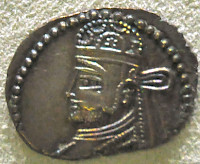Parthamaspates
Parthamaspates: pro-Roman rebel king in the Parthian Empire (r.116).

In 114 CE, war broke out between the Parthian and the Roman empires. The Roman emperor Trajan successfully conquered Armenia, occupied Edessa and Nisibis in the next year, and added Babylon, Ctesiphon and Seleucia in 116. The Parthian king Osroes I could do next to nothing, but there were anti-Roman rebellions. In Armenia, the rebel leader was a man named Sanatruces; in the south, an Arsacid prince named Mithradates V, a relative of Osroes. At the same time, the diasporic Jews revolted in Cyrenaica and on Cyprus, forcing Trajan to send troops to suppress them (more).
Although Trajan overcame all troubles, he decided that it was better to give the Parthians a king of their own and appointed Parthamaspates, a son of Osroes (116).note The new ruler never was in control of the Parthian Empire, because Trajan died a couple of months later (in 117). Osroes now could restore his power, and easily overcame Parthamaspates, who fled to the Romans.
Trajan's successor Hadrian gave up the territories that had been conquered. Parthamaspates was made king in Edessa, the capital of Osrhoene. At first, he had to share power with a local ruler, but after 123, he was to rule alone.
Note
The chronology of the Arsacid kings of the Parthian Empire is less well-understood than, for example, the sequence of Seleucid and Ptolemaic kings or the emperors of Rome. This information is based on the researches by G.R.F. Assar, as published in "Iran under the Arsakids, 247 BC – AD 224/227" in: Numismatic Art of Persia (2011).